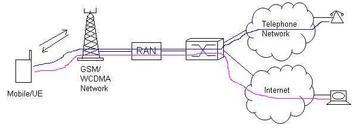Circuit Switching vs. Packet Switching in Telecom Explained
Advertisement
In the world of telecommunications, different methods exist for transmitting information. Two prominent techniques are circuit switching (CS) and packet switching (PS), each designed for specific applications. Let’s break down how these switching types work and where they’re best applied.
- Circuit Switching (CS): Ideal for voice communication, requiring a dedicated connection between the caller and receiver to minimize latency, crucial for real-time voice calls.
- Packet Switching (PS): Suited for data communication where a dedicated connection isn’t necessary. It’s well-suited for less time-sensitive data like internet browsing or email.
- Message Switching (MS): Employed for message-based communication such as SMS and MMS.
Let’s explore the conceptual differences between CS and PS in voice and data networks.
What is Circuit Switching (CS)?
Circuit switching establishes a dedicated channel before communication begins. This channel remains reserved for the duration of the active connection.
- Half-duplex: One channel is allocated.
- Full-duplex: Two channels are allocated.
CS is primarily used for real-time voice communication where minimal delay is essential.

Figure 1: Circuit Switching
In Figure 1, User A must request and obtain a dedicated channel before communicating with User C. If User B attempts to connect with User D or another user during this time, they’ll receive a busy signal, as the network’s resources are tied up.
Examples of Circuit Switching:
- Traditional telephone networks
- PSTN (Public Switched Telephone Network)
What is Packet Switching (PS)?
Unlike circuit switching, packet switching doesn’t require an initial dedicated connection. The channel is available for use by multiple users. However, increased user volume can lead to network congestion. Packet-switched networks are primarily used for data and voice applications with non-real-time requirements.

Figure 2: Packet Switching
As shown in Figure 2, User A can send data to User C simultaneously while User B sends data to User D. Data is encapsulated in packets with headers containing source and destination addresses. Intermediate switching nodes use these headers to determine the route and destination.
In packet switching, long messages are broken down into packets, which are then sent individually across the network. Packets are handled in two primary ways:
- Datagram: Each packet is treated independently and can take any available route. Packets may arrive out of order or even go missing.
- Virtual Circuit: A pre-planned route is established before any packets are transmitted. A handshake process using call request and call accept messages sets up the virtual circuit. Each packet contains a virtual circuit identifier (VCI) instead of the destination address, simplifying routing decisions.
Examples of Packet Switching:
- Internet
- VoIP (Voice over Internet Protocol)
Differences Between Circuit Switching and Packet Switching
A key difference is that circuit-switched networks guarantee quality of service (QoS), while packet-switched networks do not. Packet switching is suitable for time-insensitive applications like internet browsing, email, SMS, MMS, and VoIP. Circuit switching, however, ties up resources even when a user isn’t actively transmitting, potentially wasting capacity. PSTN is an example of circuit switching, while GPRS/EDGE exemplifies packet switching.
The following table summarizes the key differences between circuit switching and packet switching, including variations within PS (datagram and virtual circuit types):
| Feature | Circuit Switching | Packet Switching (Datagram) | Packet Switching (Virtual Circuit) |
|---|---|---|---|
| Dedicated Path | Yes | No | No |
| Path Establishment | Established for conversation | Established for each packet | Established for conversation |
| Call Setup Delay | Yes | No | Yes |
| Packet Transmission Delay | No | Yes | Yes |
| Overload Impact | May block call setup | Increases packet delay | May block call setup, increases packet delay |
| Bandwidth | Fixed | Dynamic | Dynamic |
| Overhead Bits | None after call setup | In each packet | In each packet |
Conclusion
Let’s recap the major differences between CS and PS:
- Circuit switching is used primarily for voice, while packet switching is used for data.
- Circuit switching creates a dedicated path, whereas packet switching does not. This results in sequenced communication with CS and unordered transmission with PS.
- CS is generally less cost-efficient than PS.
- Circuit switching typically incurs less delay than packet switching.
- CS is highly reliable, while PS is less reliable.
Advertisement
 RF
RF


